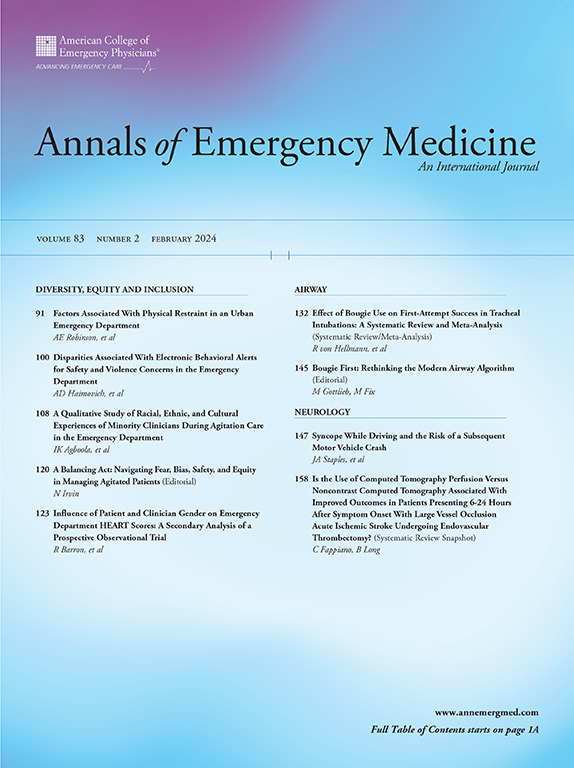Sentinel Injuries in Emergency Departments and Subsequent Serious Injury in Children.
IF 5
1区 医学
Q1 EMERGENCY MEDICINE
引用次数: 0
Abstract
STUDY OBJECTIVE Sentinel injuries in young children are minor injuries that can raise suspicion of physical abuse. Although early identification is critical, widespread screening of patients can incur unintended harm to both children and their families. We determined the frequency of serious abusive injury within 12 months following an emergency department (ED) encounter for a sentinel injury. METHODS Using the Healthcare Cost and Utilization Project State ED and Inpatient Databases, we identified children 0 to 24 months of age with an ED diagnosis of a sentinel injury between 2014 and 2019. Our primary outcome was serious abusive injury (admission for serious injury or death with a child abuse diagnosis) within 12 months of a sentinel injury ED visit. RESULTS Among 23,919 children with a sentinel injury ED visit (median age 5 months, 53% boys), bruise or fracture was diagnosed in 14,501 children (60.6%). In the 12 months following the sentinel injury visit, serious abusive injury was diagnosed in 176 (0.7%) patients. At the index ED encounter, abuse was diagnosed in 1,156 children (4.8%); 96 (8.3%) of these patients had an additional serious abusive injury diagnosed within 12 months. CONCLUSION Subsequent diagnosis of a serious abusive injury was uncommon after an initial ED sentinel injury diagnosis. Of all children in whom abuse was diagnosed during the study period, the majority of patients were diagnosed at the sentinel injury ED visit, with nearly 1 in 12 at risk for subsequent serious injury. Prospective studies are needed to further risk-stratify children with sentinel injuries.急诊科前哨伤害与儿童后续严重伤害
研究目的:幼儿的网膜损伤是可以引起身体虐待嫌疑的轻伤。尽管早期识别至关重要,但广泛的患者筛查可能会给儿童及其家庭带来意想不到的伤害。我们确定了在急诊部门(ED)遭遇前哨伤害后12个月内严重虐待伤害的频率。方法使用医疗成本和利用项目国家ED和住院患者数据库,我们确定了2014年至2019年期间ED诊断为前哨损伤的0至24个月大的儿童。我们的主要结局是在前哨伤害急诊科就诊的12个月内严重虐待性伤害(诊断为严重伤害或死亡的儿童虐待)。结果在23919例前哨性损伤急诊患儿中(中位年龄5个月,53%为男孩),14501例患儿(60.6%)诊断为瘀伤或骨折。在前哨伤访视后的12个月内,176名(0.7%)患者被诊断为严重虐待性损伤。在索引ED遭遇中,1156名儿童被诊断为虐待(4.8%);这些患者中有96例(8.3%)在12个月内诊断出严重的虐待性损伤。结论:在最初的ED前哨损伤诊断后,严重虐待性损伤的后续诊断并不常见。在所有在研究期间被诊断出虐待的儿童中,大多数患者是在前哨损伤急诊科就诊时被诊断出来的,近1 / 12的患者有随后严重伤害的风险。需要前瞻性研究来进一步对前哨损伤儿童进行风险分层。
本文章由计算机程序翻译,如有差异,请以英文原文为准。
求助全文
约1分钟内获得全文
求助全文
来源期刊

Annals of emergency medicine
医学-急救医学
CiteScore
8.30
自引率
4.80%
发文量
819
审稿时长
20 days
期刊介绍:
Annals of Emergency Medicine, the official journal of the American College of Emergency Physicians, is an international, peer-reviewed journal dedicated to improving the quality of care by publishing the highest quality science for emergency medicine and related medical specialties. Annals publishes original research, clinical reports, opinion, and educational information related to the practice, teaching, and research of emergency medicine. In addition to general emergency medicine topics, Annals regularly publishes articles on out-of-hospital emergency medical services, pediatric emergency medicine, injury and disease prevention, health policy and ethics, disaster management, toxicology, and related topics.
 求助内容:
求助内容: 应助结果提醒方式:
应助结果提醒方式:


